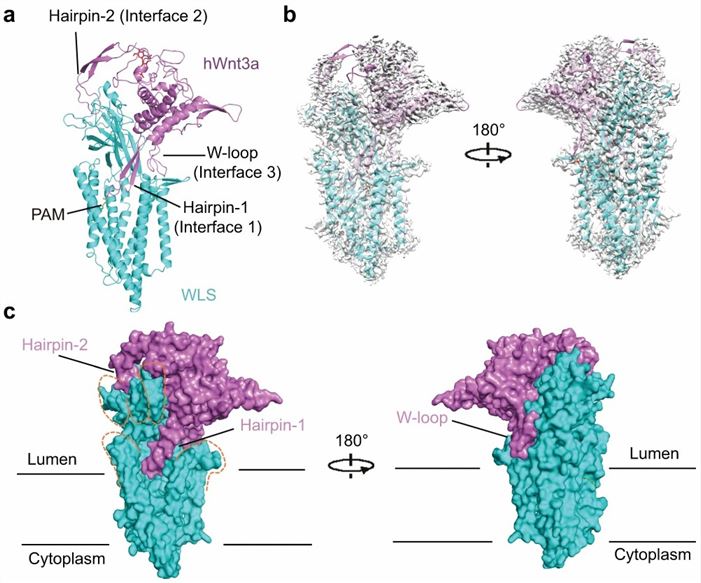What is WNT3A Protein
In the intricate field of cell biology, WNT signaling pathways are key to coordinating diverse physiological processes. Central to this pathway is the WNT3A protein, a glycoprotein encoded by the WNT3A gene that has profound effects on embryonic development, tissue homeostasis, and disease progression.
WNT3A is the abbreviation of Wingless-type MMTV integration site family member 3A and is a glycoprotein encoded by the WNT3A gene. This member of the WNT protein family acts as a key ligand, binding to cell surface receptors and initiating cascades of intracellular events that decisively influence cell behavior.
 Figure 1. Cryo-EM structure of human WLS in complex with Wnt3a (Zhong, Q., et al. 2021)
Figure 1. Cryo-EM structure of human WLS in complex with Wnt3a (Zhong, Q., et al. 2021)The Function of WNT3A Protein
- Cell Fate Determination
The major role of WNT3A in embryonic development is reflected in its contribution to the formation of the three germ layers (ectoderm, mesoderm, and endoderm). This early cellular orchestration is critical for the subsequent development of different tissues and organs.
- Tissue Homeostasis
In addition to embryogenesis, WNT3A maintains tissue homeostasis in adult organisms by regulating stem cell activity. Its effect on tissue regeneration, particularly of the intestines and skin, emphasizes its importance in the perpetual renewal of vital tissues.
- Bone Formation
In the field of osteogenesis, WNT3A occupies a central position by promoting the differentiation of mesenchymal stem cells into osteoblasts. This function makes WNT3A a potential player in therapeutic strategies for bone-related diseases.
- Neural Development
WNT3A's involvement in neural development is reflected in its impact on the differentiation of neural progenitor cells and the formation of synapses. This complex role emphasizes its importance in shaping the architecture of the nervous system.
WNT3A-Related Diseases
- Cancer
Dysregulation of WNT signaling, including aberrant WNT3A expression, is a recurrent theme in various cancers. Overactivation of the WNT signaling pathway promotes uncontrolled cell proliferation, a hallmark of cancer progression.
- Osteoporosis
Disruption of WNT3A signaling has been directly linked to bone-related diseases, particularly osteoporosis. Insufficient WNT3A activity may affect the differentiation of mesenchymal stem cells into osteoblasts, leading to decreased bone density.
- Neurological Disorders
Abnormal WNT3A signaling is associated with neurological diseases such as Alzheimer's and Parkinson's disease. The complex roles of WNT3A in neurodevelopment make it a potential target for therapeutic intervention in these diseases.
WNT3A Related Signaling Pathways
- Canonical WNT Pathway
Ligand-Receptor Interactions: WNT3A binds to cell surface receptors, including Frizzled receptors and coreceptors such as LRP5/6.
Disheveled Activation: Binding triggers the activation of Disheveled (DVL), a cytoplasmic protein central to WNT signaling.
β-Catenin Stabilization: WNT3A inhibits the destruction complex and stabilizes β-catenin in the cytoplasm.
Nuclear Translocation: Stabilized β-catenin translocates to the nucleus and forms a complex with transcription factors such as TCF/LEF to regulate the expression of WNT target genes.
- Non-Canonical WNT Pathway
The non-canonical WNT pathway is independent of β-catenin and plays a role in planar cell polarity and cell movement.
Applications of WNT3A in Biomedical Research
- Stem Cell Therapy
Leveraging WNT3A's role in regulating stem cell activity makes it an important component in stem cell culture and differentiation protocols. Its addition enhances the efficiency of directed differentiation, guiding stem cells toward specific therapeutic lineages.
- Bone Regeneration
Taking advantage of WNT3A's role in osteogenesis, researchers are exploring its application in bone regeneration. Supplementing WNT3A in scaffolds or cell-based therapies is expected to enhance bone healing in conditions such as fractures and osteoporosis.
- Cancer Therapeutics
Targeting WNT3A and the broader WNT signaling pathway is a dynamic area in cancer therapeutics. Small molecules and antibodies are being developed to modulate WNT signaling components with the aim of inhibiting uncontrolled cell proliferation and inducing apoptosis in cancer cells.
- Neurological Disorders
Researchers are studying WNT3A's potential in treating neurological disorders. Modulating WNT3A signaling may provide therapeutic benefits for diseases characterized by neuronal degeneration or dysfunction, such as Alzheimer's disease and Parkinson's disease.
Understanding WNT3A-related signaling pathways and harnessing their potential in biomedical research opens the way to innovative therapies and transformative advances in regenerative medicine, cancer treatment, and neurological interventions. As we continue to decipher the nuances of WNT3A, its profound effects on cellular processes underscore its significance as an evolving focus of molecular medicine.
Recommended Products for WNT3A Protein
| Cat.# | Species | Product name | Source (Host) | Tag |
|---|---|---|---|---|
| WNT3A-523H | Human | Active Recombinant Human WNT3A protein | CHO | N/A |
| WNT3A-1700H | Human | Recombinant Human WNT3A | CHO | N/A |
| WNT3A-1698H | Human | Recombinant Human WNT3A, His-tagged | E.coli | His |
| WNT3A-4930H | Human | Recombinant Human WNT3A protein, GST-tagged | Wheat Germ | GST |
| WNT3A-265H | Human | Recombinant Human WNT3A, StrepII-tagged | Human Cell | Strep II |
| Wnt3a-180M | Mouse | Active Recombinant Mouse Wnt3a | Insect Cell | N/A |
| Wnt3a-1050M | Mouse | Recombinant Mouse Wnt3a Protein, His-tagged | Yeast | His |
| Wnt3a-586R | Rat | Recombinant Rat Wnt3a Protein, His-tagged | E.coli | N-His |
| WNT3A-1660Z | Zebrafish | Recombinant Zebrafish WNT3A | Mammalian Cell | His |
| WNT3A-4054C | Chicken | Recombinant Chicken WNT3A | Mammalian Cell | His |
Reference
- Zhong, Q., et al. Cryo-EM structure of human Wntless in complex with Wnt3a. Nat Commun. 2021, 12: 4541.

